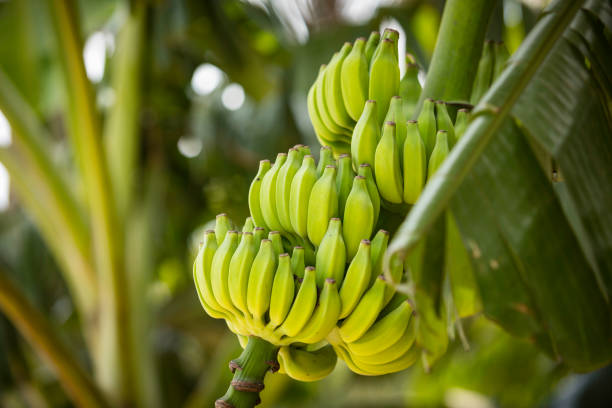Banana trees are more than just tropical ornaments; they are a fruit tree that gives all year round in India, making them one of the most beneficial and versatile plants to cultivate in your home garden or farmland. With rich cultural significance, nutritional value, and low maintenance needs, banana trees are a staple in Indian agriculture and daily life. Whether you’re a backyard gardener or an eco-conscious landowner, understanding the benefits and growing techniques of banana trees can transform your green space into a fruitful haven.
Why Banana Trees Are a Year-Round Marvel
The banana tree (technically a giant herb) is unique in its continuous fruiting ability. Unlike seasonal trees like mango or guava, bananas produce fruit throughout the year with proper care. A single banana plant can produce a large bunch every 9 to 12 months, depending on the variety and climatic conditions. In India’s diverse agro-climatic zones, especially tropical and subtropical regions, bananas grow abundantly with minimal effort.
Benefits of Planting Banana Trees in India
1. Continuous Yield
Bananas are among the few fruit trees that bear fruit year-round, ensuring a consistent supply of food and income.
2. Nutrient-Rich Fruit
Bananas are rich in potassium, fiber, vitamins B6 and C, making them an energy-boosting, digestive-friendly fruit.
3. Eco-Friendly and Multipurpose
Every part of the banana tree is usable — leaves are used in traditional meals, the trunk in compost, and the fruits and flowers in cooking and medicine.
4. Low Maintenance
Banana trees need moderate watering, well-drained soil, and occasional organic feeding, making them perfect for low-effort farming.
Ideal Climate and Soil for Banana Cultivation
Banana plants love warm, humid conditions, making India’s climate ideal. The optimal temperature range is between 20°C to 35°C. They require:
- Well-drained loamy soil
- Plenty of sunlight
- Protection from strong winds
Rainfall between 1000–2500 mm per year is ideal. States like Kerala, Tamil Nadu, Maharashtra, and Andhra Pradesh lead in banana cultivation.
How to Plant Banana Trees: Step-by-Step Guide
- Choose a location: Ensure full sunlight and protection from heavy wind.
- Soil preparation: Mix compost with well-drained soil for nutrient-rich ground.
- Spacing: Plant suckers or tissue-cultured plants 6-8 feet apart.
- Watering: Regularly water during dry periods; avoid overwatering.
- Fertilization: Apply organic compost or cow dung every month.
- Mulching: Retain moisture and suppress weeds with leaf mulch.
- Support: Tie young trees to stakes in windy regions.
Popular Banana Varieties in India
- Dwarf Cavendish – Ideal for home gardens.
- Robusta – Common in South India.
- Rasthali – Sweet and flavorful.
- Poovan – Hardy and widely grown.
- Nendran – Popular in Kerala, used for chips and cooking.
How Banana Trees Compare with Other Fruit Trees
If you’re deciding between different fruit trees, bananas stand out for:
- Faster growth than papaya
- More frequent harvests than pomegranate
- Less maintenance than custard apple (Sitaphal)
Banana trees are a staple in many Indian homes alongside lemon and jamun trees.
Sustainable Agriculture and Banana Trees
Banana cultivation supports eco-friendly farming practices. Since it can be intercropped with coconut or sapota (chikoo) trees, it improves land use efficiency. Plus, the plant’s biodegradable components can be used as natural mulch and compost, making your garden more sustainable.
Pest & Disease Management
While bananas are hardy, common issues include:
- Panama disease (Fusarium wilt)
- Bunchy top virus
- Aphids and weevils
Use natural remedies like neem oil sprays and maintain proper drainage to prevent most problems. Tissue-cultured plants are more resistant.
Harvesting and Post-Harvest Care
Bananas are harvested when the fingers are full and the skin turns light green. Post-harvest care includes:
- Cutting the bunch carefully
- Washing with clean water
- Ripening in a controlled environment or naturally in a warm spot
Cultural and Economic Significance
In Indian culture, the banana tree symbolizes prosperity and fertility. It is used in wedding ceremonies, religious rituals, and traditional meals. Economically, it supports thousands of farmers across India.
FAQs About Banana Trees in India
Q1: How long does a banana tree take to bear fruit? A: Typically, banana trees take 9–12 months to produce fruit after planting.
Q2: Can banana trees grow in pots? A: Yes, dwarf varieties like Dwarf Cavendish grow well in large containers with proper care.
Q3: Do banana trees need a lot of water? A: They need regular watering but should not be waterlogged. Drip irrigation is effective.
Q4: What is the lifespan of a banana plant? A: A mother plant fruits once and then dies, but new suckers from its base grow to continue the cycle.
Q5: Are banana trees good for small gardens? A: Absolutely! Choose compact varieties and ensure adequate sunlight and soil nutrition.
Q6: Can banana trees grow with other fruit trees? A: Yes, they grow well with coconut and papaya in tropical gardens.
Final Thoughts: A Tree of Many Gifts
If you’re looking to start or expand your garden with a fruit tree that produces all year, the banana tree is your ideal companion. It offers beauty, nutrition, sustainability, and cultural value in one lush package. From continuous fruiting to eco-friendliness, banana trees are truly a wonder of Indian horticulture.
Explore more about other Indian fruit trees like the king mango, the fiber-rich guava, and the medicinal jamun on our blog.
Related Articles
- Papaya Power: Fast-growing fruit tree that thrives in Indian soil.
- Lemon Tree Benefits: Citrus trees made for Indian backyards.
- Pomegranate Guide: Planting this red gem at home.
- Chikoo Trees: Sweet returns in warm climates.
- Custard Apple Tips: Perfect for low-maintenance gardens.
- Coconut Tree Plantation: Sustainable yields in tropical zones.
treesplantsinfo.com – Your trusted guide to planting green, living clean, and growing fruit trees the Indian way.
